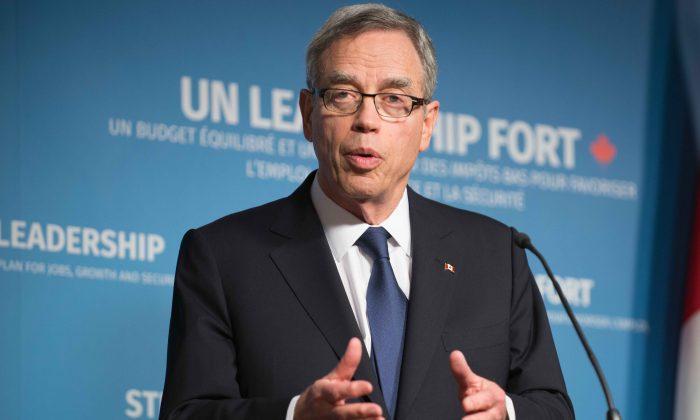OTTAWA—Canada is setting an example for prudent fiscal management and Budget 2015 should ensure it continues to have one of the strongest balance sheets among the Group of Seven nations.
Canada has come a long way from the depths of the financial crisis in 2008 (budget deficit of $55.6 billion) to a projected surplus of $1.4 billion for 2015-16. Canada ran a $2 billion deficit for the 2014-15 fiscal year.
“We have been prudent. We have been practical. And we have stuck to our plan,” said finance minister Joe Oliver in his budget speech.
The government’s newest measures—support for Canadian families, small businesses, and infrastructure investments ($9.8 billion in the current fiscal year)—provide support to the lackluster economy starting immediately. The Bank of Canada announced on April 15 that it is expecting no growth for the first quarter of 2015.
The nearly $10 billion in measures works out to about 0.5 percent of GDP. Nevertheless, the government remains on target to reach a federal debt-to-GDP ratio of 25 percent by 2021 and to reduce it to pre-recession levels by 2017. The current ratio is 31.2 percent.
In addition, Canada has the lowest total government net debt-to-GDP ratio of any G-7 country currently 38.3 percent. By comparison, the next lowest in the G-7 is Germany at 46.0 percent. The U.S.’s ratio is 80.4 percent.
Managing the Oil Price Plunge
The oil price shock has had a profound impact on the Canadian economy, a net oil exporter, and the impact to the government’s budgetary balance is striking.
Canada’s crude oil exports in the second quarter of 2014 (before the oil price shock) was worth $100 billion (5.1 percent of nominal GDP). From then to February 2015, the oil price shock dropped the value of exports by $40 billion (2 percent of GDP) with export volumes basically unchanged.
Private sector economist forecasts from March are used in fiscal planning. The average forecasts for real GDP has been revised lower in the near term mainly due to the oil price shock. The budget assumes real GDP growth of 1.2 percent in the first quarter of 2015, rising gradually to 2.3 percent in fourth quarter.
In the fall budget update, oil (West Texas Intermediate) was expected to average US$96 in 2015, but that has now been revised to US$54. The economists forecast oil to rise to US$67 in 2016 before climbing to US$80 range in 2019. This is significantly below the US$100 range forecast in the September.
Last November, the government was projecting a $1.9 billion surplus for 2015-16 ($4.9 billion including the old $3.0 billion set-aside for contingencies). Due to the oil price shock on government revenues, the largest component responsible for a hit of $6 billion, and prior program commitments, the status quo budgetary balance ended up at a then surplus of $1.8 billion, including the new set-aside for contingencies of $1.0 billion.
That hit of $6 billion included the gain from the April 6 divestment of GM shares, which resulted in a net gain of $2.1 billion.
Factoring in measures in Budget 2015, the budgetary balance drops $400 million to the $1.4 billion surplus projected for 2015-16.
This surplus is projected to grow to $4.8 billion by 2019-20—and proposed balanced budget legislation will aim to make sure the surplus gets there without any dips along the way.
The contingency reserve has been dramatically reduced to $1.0 billion a year for the next three years from $3.0 billion last year. This reflects the government factoring in being in an expected surplus position and a more balanced outlook of risks now that the oil price shock has already taken place. The contingency reserve grows to $2.0 billion in 2018-19 and $3 billion in 2019-20. If this set-aside for contingencies not used, it will be applied to reduce the federal debt.
Canada is expected to maintain its AAA rating in the year ahead from four credit rating agencies Moody’s, Fitch, Standard & Poor’s and DBRS.
“Our country remains a beacon of economic stability and security built on a foundation of strong financial management,” said Oliver.
Follow Rahul on Twitter @RV_ETBiz





